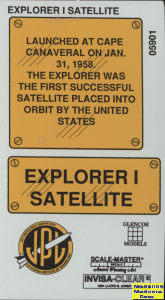Glencoe 1/6 Explorer I
|
KIT #: |
05901 |
|
PRICE: |
$9.98 when new |
|
DECALS: |
One option |
|
REVIEWER: |
Scott Van Aken |
|
NOTES: |
1961 tooling |
 Explorer
1 was the first satellite launched by the United States in 1958 and was part
of the U.S. participation in the International Geophysical Year (IGY). The
mission followed the first two satellites the previous year; the Soviet
Union's Sputnik 1 and Sputnik 2, beginning the Cold War Space Race between
the two nations.
Explorer
1 was the first satellite launched by the United States in 1958 and was part
of the U.S. participation in the International Geophysical Year (IGY). The
mission followed the first two satellites the previous year; the Soviet
Union's Sputnik 1 and Sputnik 2, beginning the Cold War Space Race between
the two nations.
Explorer 1 was launched on 1 February 1958 at 03:47:56 GMT (or 31 January
1958 at 22:47:56 Eastern Time) atop the first Juno booster from LC-26A at
the Cape Canaveral Missile Test Center of the Atlantic Missile Range (AMR),
in Florida. It was the first spacecraft to detect the Van Allen radiation
belt, returning data until its batteries were exhausted after nearly four
months. It remained in orbit until 1970.
Explorer 1 was given Satellite Catalog Number 00004 and the Harvard
designation 1958 Alpha 1, the forerunner to the modern International
Designator.
 Glencoe's
kit of the Explorer I is a rebox of the older ITC kit of 1961. Glencoe acquired
all the old ITC tooling and this was one of those kits. This kit was released in
1991 and again in 2008.
Glencoe's
kit of the Explorer I is a rebox of the older ITC kit of 1961. Glencoe acquired
all the old ITC tooling and this was one of those kits. This kit was released in
1991 and again in 2008.
The kit is of the satellite itself and not the main Jupiter C
booster (called Juno 1). At 1/6 scale the completed model will stand around a
foot tall. As you'd expect, you are able to build up the interior items of the
satellite. Much of the space in the interior is taken up by a fuel tank. The
upper section has two interesting constructs the purpose of which I have no
clue. This is encased in a lattice work that is then installed in one of the
body halves. There is a nozzle assembly that fits below all this. One half of
the satellite has a door you can open to display the interior. Four sections of
wire are provided for the antennas that jut out the sides.
 A rather
neat part of this kit is a rather large display stand. Inside this stand are a
number of gears. These lead out to a crank handle on the side and a small
rotating platform on the upper part. Atop this platform, one places the
satellite and so it can be cranked to display all sides of it.
A rather
neat part of this kit is a rather large display stand. Inside this stand are a
number of gears. These lead out to a crank handle on the side and a small
rotating platform on the upper part. Atop this platform, one places the
satellite and so it can be cranked to display all sides of it.
The instructions are all pictograms with generic color
information. Each of the construction steps is easy to follow so there should be
no issue assembling the kit. A decal sheet is provided that has two markings for
the stand and one for the satellite body. Note that the black areas shown will
need to be painted on so there will be masking required.
As this is a fairly old kit, I'm going to assume that careful
construction will be needed to get everything to work well. I'd recommend some
grease for the gears in the stand to help smooth things along.
https://en.wikipedia.org/wiki/Explorer_1
July 2022Copyright ModelingMadness.com. All rights
reserved. No reproduction in part or in whole without express permission from
the editor.
If you would like your product reviewed fairly and fairly quickly, please contact the editor or see other details in the
Note to
Contributors.
Back to the Main Page
Back to the Review
Index Page
Back to the Previews Index Page
 Explorer
1 was the first satellite launched by the United States in 1958 and was part
of the U.S. participation in the International Geophysical Year (IGY). The
mission followed the first two satellites the previous year; the Soviet
Union's Sputnik 1 and Sputnik 2, beginning the Cold War Space Race between
the two nations.
Explorer
1 was the first satellite launched by the United States in 1958 and was part
of the U.S. participation in the International Geophysical Year (IGY). The
mission followed the first two satellites the previous year; the Soviet
Union's Sputnik 1 and Sputnik 2, beginning the Cold War Space Race between
the two nations.
 A rather
neat part of this kit is a rather large display stand. Inside this stand are a
number of gears. These lead out to a crank handle on the side and a small
rotating platform on the upper part. Atop this platform, one places the
satellite and so it can be cranked to display all sides of it.
A rather
neat part of this kit is a rather large display stand. Inside this stand are a
number of gears. These lead out to a crank handle on the side and a small
rotating platform on the upper part. Atop this platform, one places the
satellite and so it can be cranked to display all sides of it.